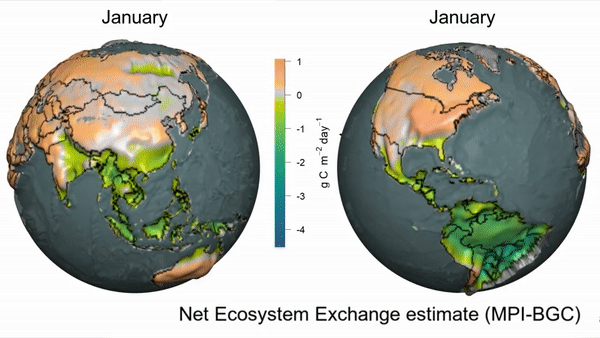Earth inhales and exhales carbon in mesmerizing animation
The animation shows plants taking up and releasing carbon as the seasons change.
The Earth seems to inhale and exhale in a new animation that shows how carbon is taken up and released as the seasons change.
The animated continents seem to deflate during summertimes, indicating times and places where vegetation is growing and plants are sucking carbon dioxide out of the atmosphere. When it's winter, the continents seem to inflate, indicating that vegetation is dying off and carbon is being released.
The changes are most striking at temperate latitudes like continental Europe and North America, where seasonal differences are more pronounced. Equatorial regions don't change as much throughout the year, while some desert regions, being sparsely vegetated, don't store or release much carbon at all.
The data for the animation comes from satellite observations and hundreds of carbon-monitoring stations worldwide, said Markus Reichstein, the director of the Biogeochemical Integration Department at the Max-Planck-Institute for Biogeochemistry in Germany, who posted the animation on Twitter on Jan. 6.
"The visualization is really just a fun project," Reichstein told Live Science.
What the animation ultimately shows is an important portion of the carbon cycle, or the flow of carbon throughout the planet's system. Carbon can be released into the atmosphere by decaying organic material and by the erosion of rocks containing carbon compounds; conversely, it can be taken up by the oceans and by plants, which use carbon in the process of photosynthesis.
The importance of plants is clear in the animation, which shows places chock full of plants such as the Brazilian Amazon and the forests of Eastern Europe taking in massive amounts of carbon in the southern and northern hemisphere summers, respectively. The ocean isn't included in the animation, because while the ocean does take in carbon, it does not show strong seasonal patterns, Reichstein said.
Get the world’s most fascinating discoveries delivered straight to your inbox.
Climate change is altering the pattern of vegetation growth around the globe, Reichstein said, so the flow of carbon in and out of the biosphere is also changing. Those changes are too small to show up on a visualization such as this one, he said, but they will have different impacts in different places. For example, warmer, longer summers in the Northern Hemisphere can be good for plant growth, he said. But where warming comes with a lack of precipitation — as in much of the American West — climate change can restrict plant growth.
"This carbon cycle and how it changes from month to month tells us a lot," Reichstein said. But when it comes to societal impact, he said, the takeaway message is that forests are crucial to the planet's health. Recent research finds that the Amazon, one of the biggest carbon sinks on the planet, has recently been releasing more carbon each year than it takes in thanks to deforestation and wildfires, Live Science reported.
"It basically is showing how important it is to protect the carbon sinks," he said.
Originally published on Live Science.

Stephanie Pappas is a contributing writer for Live Science, covering topics ranging from geoscience to archaeology to the human brain and behavior. She was previously a senior writer for Live Science but is now a freelancer based in Denver, Colorado, and regularly contributes to Scientific American and The Monitor, the monthly magazine of the American Psychological Association. Stephanie received a bachelor's degree in psychology from the University of South Carolina and a graduate certificate in science communication from the University of California, Santa Cruz.
 Live Science Plus
Live Science Plus






